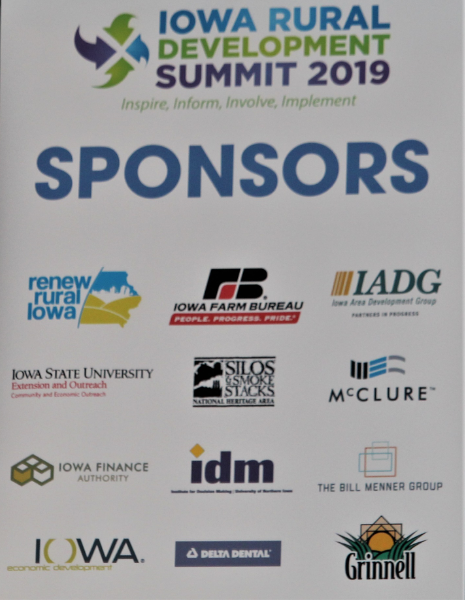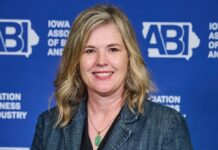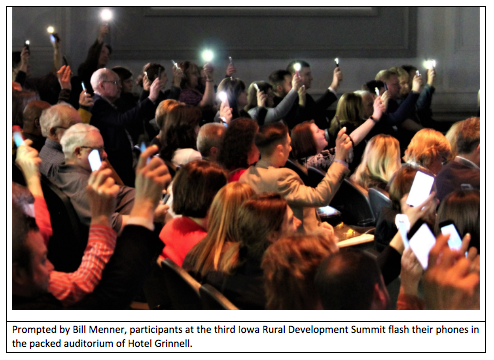
Lights Shine on Small-Town Strategies at Rural Development Summit in Grinnell
Prompted by Bill Menner, participants at the third Iowa Rural Development Summit flash their phones in the packed auditorium of Hotel Grinnell.
By Michael McAllister
In Grinnell, circa 1915, merchants along Broad Street worried that they were being out maneuvered by merchants on Main Street. They, the Broad Streeters, needed to divert people one block east, so they devised a plan.
They pooled their money—some $15,000 (keep in mind, this is more than a century ago)—and bought a piece of ground on the southeast corner of 5thand Broad. They convinced the post office to move there from a basement location in the Spaulding Building on Main.
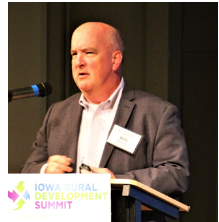
That account of early-twentieth-century economic development comes from Bill Menner’s book, Grinnell in Vintage Postcards. Menner, as Executive Director of the Iowa Rural Development Council, continues to tell stories about economic development in towns like Grinnell, and he has gone one step further: he, along with colleagues in the Iowa economic development community, is inspiring such stories.
The third Iowa Rural Development Summit, sponsored by the Iowa Rural Development Council and partners, took place for the second year in Grinnell on April 10-12. The conference drew 372 people representing 76 communities. Out of the 372, more than 100 attended the conference on the custom video conferencing application that the council members designed using their own video conference script.
“We were thrilled with every element of the Summit. Grinnell was the perfect host and the hotel was the perfect venue,” Menner, right, commented.
The Iowa Rural Development Council initiated the first Rural Development Summit in 2017 in Jefferson. The Council viewed the initiative as a means of becoming “a resource provider and catalyst for identifying and addressing rural issues,” according to the organization’s website.
The concept of the summit is simple but effective: Bring together community leaders—at least three on a team—from towns with populations under 20,000; let participants learn about success stories, problem-solving opportunities, creative solutions, and resources both public and private; provide them with opportunities for collaborative planning and assessment; then let them go back home and get to work.
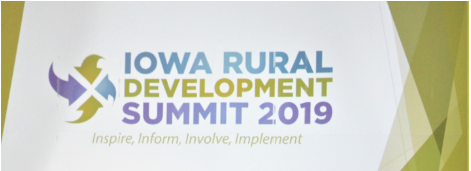
Following pre-conference workshops on April 10, the April 11 session began with a welcome from Grinnell’s Mayor Dan Agnew and from Chair of the Iowa Rural Development Council Sandy Ehrig.
Debi Durham, Director of both the Iowa Economic Development Authority and the Iowa Finance Authority, also welcomed attendees and stressed that, despite the dark picture about rural Iowa often portrayed by the media, she is optimistic.
“I believe there is power in looking to the future with an expectation of positive change,” Durham remarked. She reported, for example, that 34 rural Iowa counties saw population growth from 2015 to 2017, and she cited several statistics highlighting progress achieved through programs administered by the Iowa Economic Development Authority.
Durham praised specific projects in the towns of Stanton, Lenox, Forest City, and Centerville and commended Governor Reynolds and her Empower Rural Iowa initiative.
Introducing a theme that was often repeated during the summit, Durham called for communities to collaborate, to pool resources, to think regionally, to assist and utilize one another.
“Now that IFA (Iowa Finance Authority) and IEDA (Iowa Economic Development Authority) are one, you’ll see us do more work where we leverage complimentary programs…across our great state,” Durham predicted.
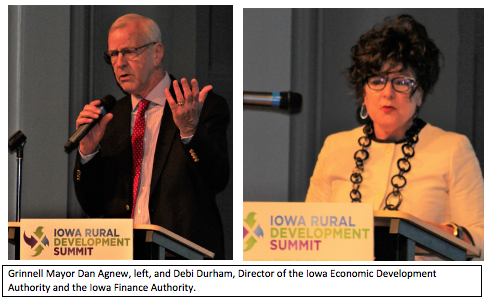
Durham called on participants to “change the narrative” from pessimism to optimism, stressing “Attitude is everything.”
Grinnell Mayor Dan Agnew, left, and Debi Durham, Director of the Iowa Economic Development Authority and the Iowa Finance Authority.
“Y’all talk funny up here,” joked Patrick Woodie, below right, CEO of North Carolina Rural Center, keynote speaker of the summit, as he led into his address entitled “Growing Better, Together!”
He pointed out that those of us who live in rural communities will often speak of being “in the middle of nowhere”; yet our home is “the most important place in the universe” for us. North Carolina Rural Center, created in 1987, serves the 80 rural counties of North Carolina, a rural county defined as maintaining a population density of fewer than 250 people per square mile.
The North Carolina Rural Center is privately funded. Priorities for 2019 include expanding broadband capacity, stabilizing health care, and supporting entrepreneurial efforts—priorities that reflect Iowa needs.
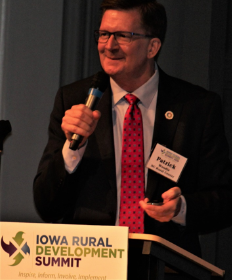
Woodie discounted the so-called rural-urban divide, calling it more a creation of the media than a reality. He stressed “reclaiming the rural narrative” and, like Durham, noted the importance of working regionally, the importance of collaboration and partnerships.
Location need not limit achievement, he asserted, as he encouraged attendees to “do some really excellent work because our communities deserve it.”
In the first panel discussion of the full summit, “Empower Rural Iowa—What We’ve Learned / What Comes Next,” facilitated by Debi Durham, participants raised themes that would arise again throughout the session: collaboration, connectivity, and confidence.
The morning session closed with presentations by exhibitors prior to a working lunch.
Thursday afternoon’s panel discussions dealt with topics such as broadband expansion, leadership strategies, housing practices, community development block grants, and child care options.
Like the theme of collaboration, the importance of connectivity reverberated through the summit. One session, entitled “Connecting Rural Iowa: Lighting Up High-Speed Broadband,” dealt with strategies to achieve maximum connectivity. Dependable, fast, secure connection to the World Wide Web, a novelty 20 years ago, is a necessity now if communities are to progress.
While fiber to the home is ideal, that solution is not practical or possible for all people in all rural areas. However, combinations of fiber and fixed wireless services can work. Again, the principle of collaboration is paramount. Roxanne White of Evertek in Everly, Iowa, stressed the differing needs of communities and the differing methods of servicing those needs.
“We have put together probably 25 different models…not one is the same,” she stated, illustrating the variety of scenarios that ISPs, internet service providers, need to meet.
Another of Thursday afternoon’s panel discussion focused on retail strategies in Iowa’s small towns.
Panelists included Ann Greenwald of Carver’s Ridge Engraving in Corning, a town of approximately 1,500. She explained how the concept of a “click and mortar” store has helped her expand her business and her customer base.
Greenwald emphasized the importance of giving to the community as a business grows and the utilization of social media to promote that growth.
Another panelist, Joe Jennison of Mount Vernon, related several small-business success stories from his town of approximately 5,000 people.
Development of a former middle school building as a business incubator has proven effective for the community. Businesses that have started there and gone on to locate on Main Street include a pet food store, Zoe’s Deli, featuring homemade doggie treats.
In another instance, he convinced an owner of a building used for storage to convert it to space for an entrepreneur, and the result is a business called Kae Apothecary that is on Main Street today.
Jennison reported that in Mount Vernon there are events happening almost every weekend to draw people to the town, and he added, “We’ll show you a good time.”
Thursday’s events concluded with recognition of Community Catalyst Awards and remarks by Governor Kim Reynolds and Lieutenant Governor Adam Gregg.
“I love what you’re doing,” Governor Reynolds enthused, referring to the efforts of attendees, and she praised Lieutenant Governor Adam Gregg for leading Empower Rural Iowa.
“Keep it up. Keep doing what you’re doing, Reynolds instructed.
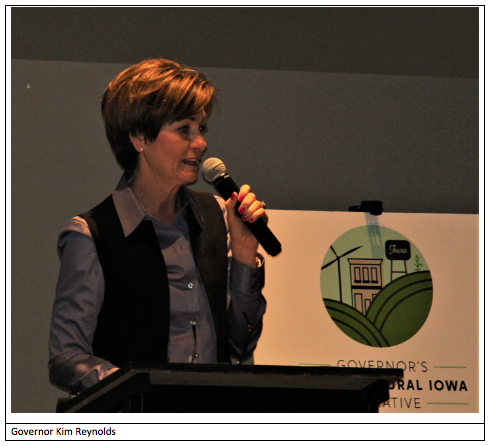
Adam Gregg spoke about the honor of co-chairing the Empower Rural Iowa Initiative, and he introduced Jim Thompson, small-town specialist, of the Iowa Economic Development Authority, who prepared to introduced the Community Catalyst Awards totaling $2.9 million.
Community Catalyst Grants, administered by the Iowa Economic Development Authority, go to communities that have applied with proposals to renovate buildings when doing so will provide the potential for economic improvement in the town, particularly private sector investment. Of grants awarded, 40% must go to towns of fewer that 1,500 -people.
A Community Catalyst Grant is $100,000. As an example, consider Bedford, Iowa, a town of about 1,400 near the southern border of the state in Taylor County. Bedford received $100,000 to apply to the cost of a $335,000 project to restore the Garland Hotel and Bedford House. Similar awards went to similar projects in nearly 30 Iowa communities.
Friday’s events offered more sharing opportunities for community leadership teams and information about funding opportunities and promotional strategies.
Next year’s Iowa Rural Development Summit is already in the planning stages. Forward-thinking community leaders should already be circling the dates of April 15-17, 2020, on their calendars.
